Car-Free Kea: A Cycladic Island Escape Near Athens
Just an hour from Athens, Kea...
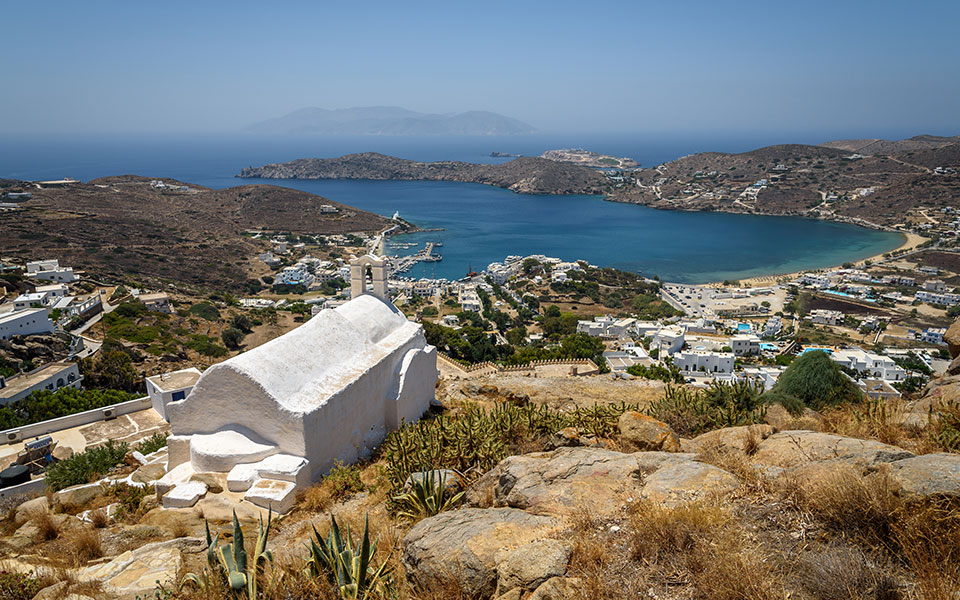
© Shutterstock
The little white church on the right – one of 365 in Ios, if you believe the lore – recedes from view as we glide into Ormos harbor, and what I see stepping off the ship are Greek officers clutching machine guns. I’m arriving at what is supposed to be the most uncomplicated of the Cycladic islands and I’m feeling positively flummoxed. I need to stop scribbling in my notebook. Also, I need to find a hotel.
I like charming ports in parts lesser known, but I don’t always like to know in advance where I’m going to stay. Ios isn’t Santorini, so I figure I’ll take my chances. And it seems my bet is going to pay off, because not a five-minute walk from the port I spot an intriguing little spot called the Five Star Hotel. A bit cheeky as names go, but refreshingly honest. Then I remind myself I’m on an island made famous by hippies so perhaps the name has some astrological connotation? I wheel my suitcase up to the edge of a breezy terrace to get an eyeful of the lobby without having to go all the way inside, but am almost instantly stopped by a gruff security officer: “What are you doing here?” he asks in halting English. “Are you on the list?
“What list?” I do a double take. “I’m just looking for a room…”
“Well if you’re not the list, then you’re not getting in,” he snaps. Speechless, and frankly a little shamed, I turn around and wheel my suitcase in reverse. I pop into Votsalo, what I assume to be the hotel’s gift shop next door, for a little retail succor.
“That must be some fancy hotel!” I blurt out to the shopkeeper, pointing to the tricked-out terrace behind me.
“Oh that’s not a hotel,” she says, nonplussed. It’s the set of a British reality TV show.”
So now it starts coming together. “I see. Anybody famous?”
She replies with a laugh and twinkling eye: “Some of them think they are.”
For a Hora stay with a contemporary touch there’s the Hotel Avanti, while the fanciest place in town is the five-star Liostasi Hotel & Suites. The reason I favor Kritikakis Village Hotel is because it’s located just behind the port and adjacent to the walking path to Hora, so you have the best of both worlds: it’s a quick dash to the ferries but if you want to go out you’re close to the action, but in a calmer spot than Hora itself. The rooms are done up in a simple Cycladic style and are spacious, most having terraces with views over Gialos bay too.
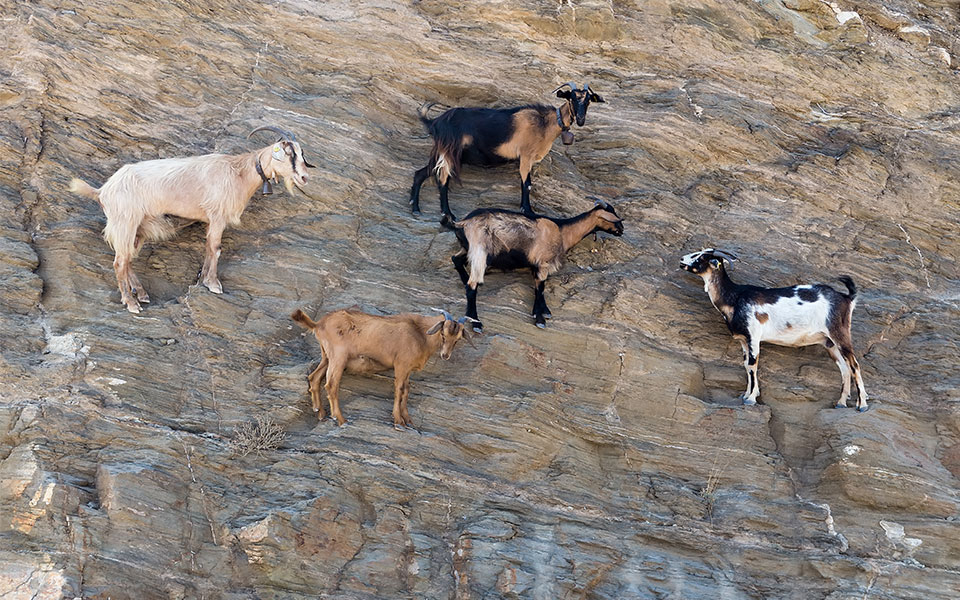
© Shutterstock
I assume that the presence of machine guns in the harbor is also part of the show’s security detail – perhaps the Great Kardashian herself is on Ios to make a cameo? Alas, no sign of Kim, or Paris Hilton either: there was actually a group of Israeli tourists who apparently requested extra stringent security.
You learn things in Ios by chatting up the locals. And it seems like for every conversation you have, another cliché falls away.
I have to confess – and no, the presence of all those churches has nothing to do with the confession – that prior to this sudden sojourn I had never given much thought to Ios. All I know is that whenever my Greek friends mention the island it is in the context of rather colorful vacations they took there while still in high school or maybe college: a Cycladic version of Daytona Beach, I figure. And it makes sense: after all, I wouldn’t expect the youth of Greece to splash out in Mykonos à la Paris Hilton or latterly Katy Perry, nor should they want to when an altogether cheaper, arguably lovelier island is so readily available in the vicinity. (After all, what real New Yorker does their shopping in Soho?)
While Mykonos has a magic of its own, Ios has a groove. Some comes from 1970s counterculture. Some is syllabic: its name carries with it the deceptively simple, charged eroticism of a Bali or Ibiza, and is said to stem from an ancient Greek word for flowers – possibly violets.
The fastest option is the Hellenic Highspeed ferry (hellenicseaways.gr) which makes a stop at Sifnos and gets you to Ios just under four and a half hours. Longer routes with Seajets make stops in Milos and Folegandros before arriving at the island’s only port, while the Piraeus-Ios route on Blue Star ferries will stop at Paros and Naxos first. Also note that Ios is very close to Santorini (which is where the nearest airport is located) and ferries between the islands are fast and frequent, taking as little as 35 minutes. Finally, from Heraklion (the largest city in Crete) to Ios the ferries are about two and a half hours (making a stop in Santorini).
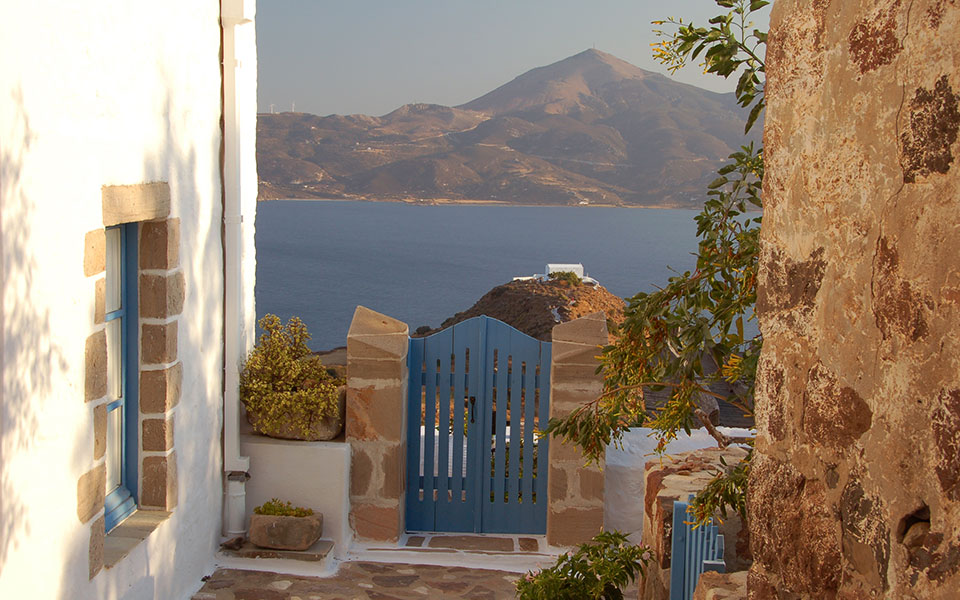
© Shutterstock
Situated about midway between Naxos and Santorini, Ios is wild in aspect; hilly, rugged and sometimes startlingly empty. The dizzying heights that stand between many of the seaside clifftops and the chiseled coves below call to mind Crete, and Crete is what brings me here, actually. That’s because for the traveler in Athens who doesn’t want to fly and is disinclined to take an overnight ferry that arrives in Crete sometime around dawn, Ios is your quietly fabulous Aegean middleman. I scoured the ferry schedules and all roads (well, sea lanes) pointed to Ios as the natural halfway mark between Piraeus and Heraklion.
The journey is eminently doable this way, even in a single day, on Seajets: a 7AM departure will have you in Ios in time for a leisurely lunch, before a 3:40-ish onward journey to Heraklion. But while my intention is to simply pass through I find myself incrementally bewitched. Three days will pass, and I will still be reluctant to see the island’s voluptuous backbone recede behind a trail of sea foam.
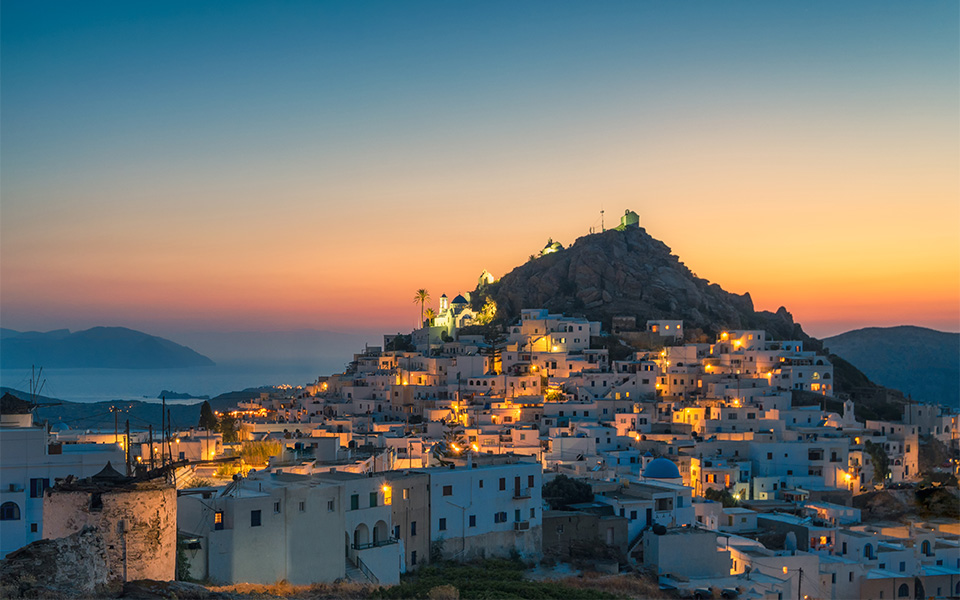
The Hora of Ios at sunset
© Shutterstock
Its fake and mercifully temporary five-star hotel notwithstanding, there is much to adore about the Port of Ios and a lot of that has do with what isn’t there: no crush of T-shirt shops, no achingly Instagrammable whitewashed lanes and the boatloads of cruise ship passengers that trundle through them with too little time and too many selfie sticks.
Still wheeling my suitcase, I poke around a bit and find an Italian restaurant-café with a sign inside that shouts, “We have the world’s best pizza!” I can’t help but chuckle at the hubris, but on another day I try it and it turns out to be the one of the best damn pizzas I have ever had anywhere, and I’ve lived in New York. The owner, as it happens, is from Bologna – Italian foodie heaven.
There’s a smattering of seaside cafés, the broad if unspectacular Gialos Beach, a few nondescript hotels. Everything is simple, and I am still ignorant of the fact that Hora, the main town on Ios and where twisting lanes and higher, prettier views abound is actually a good 20-minute walk up a donkey path.
And I may be headed in that direction but as I start to wheel my suitcase up the slope I am interrupted by the sight of a tall Greek gentleman in a white doorway wielding not a machine gun, but a cigarette and smoking it, with an adoring puppy at his feet. He is Vangelis, son of the owner of Kritikakis Village Hotel, and in that instant I decide that his hillside domain will be my Ios island home, at least for a while – and why? Because it seems lovely, Vangelis is totally nice and checking in now means I don’t have to schlep my suitcase up the donkey path later. Joy.
Ios basically has just one town with a split personality: the little Port of Ios, on the fringe of the harbor called Ormos, is also the front door to the main town of Hora, which you can access via pathway from the harbor. The path is fairly steep, but generally you can cover it in about 15 minutes on foot. Built amphitheatrically on a hilltop, Hora hits all the “Cycladic look” notes with its whitewashed houses packed in close together, winding lanes and cluster of old windmills. The streets are chock-a-block with bars, restaurants and shops (more or less in that order). Driving in any direction from Hora you quickly realize just how empty most of Ios is: while the more popular beach spots like Milopotas have the requisite range of beach bars and mini-markets and there are some tiny settlements in the interior, there are no other bonafide villages apart from Ios port and Hora.
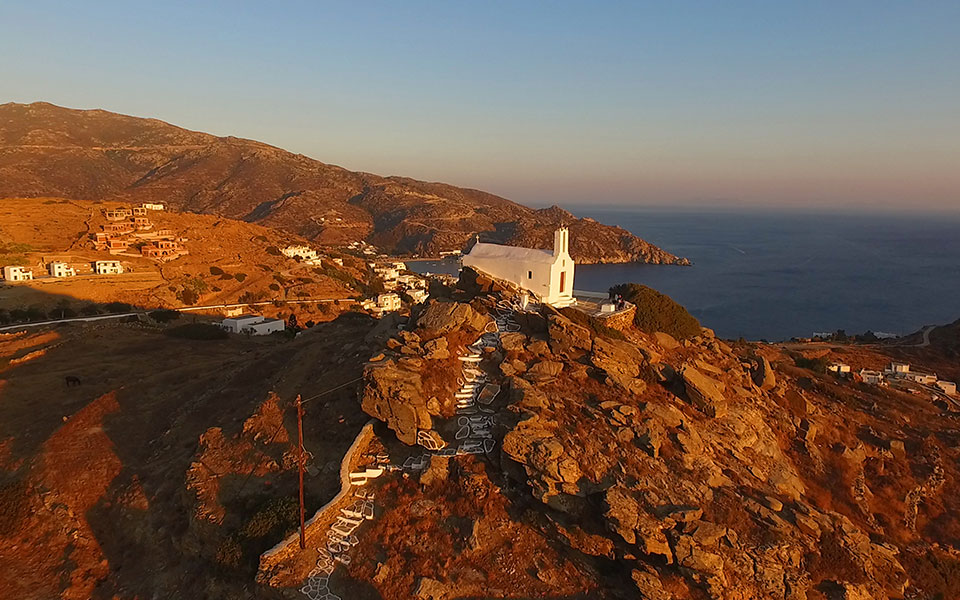
The local lore has it that there are 365 churches on Ios - one for every day of the year.
© Shutterstock
Now, I am not the type to be easily beguiled, but the churches of Ios are going to cast a spell on me. I’m not even Christian, or in the least bit religious, but there is a spirit here – one that you can feel best by renting a car.
If you can pardon the preceding blasphemy, please hear me out: I have now no reason to doubt there is one church for every day of the year on this island of a mere 11 miles diameter and six miles wide. In fact by driving you could almost be forgiven for thinking there are enough for two years because they are as ubiquitous as they are unobtrusive: for every sweeping mountain and sea view, there’s a perfect little white-domed church seemingly custom-made to bless it. They fly past you as you accelerate – yes, check the rear-view mirror, that was no gas station behind you but a chapel – and this steady succession of holy places almost becomes a religious experience. Church is in silent session everywhere and you’re in attendance without even cracking open the window.
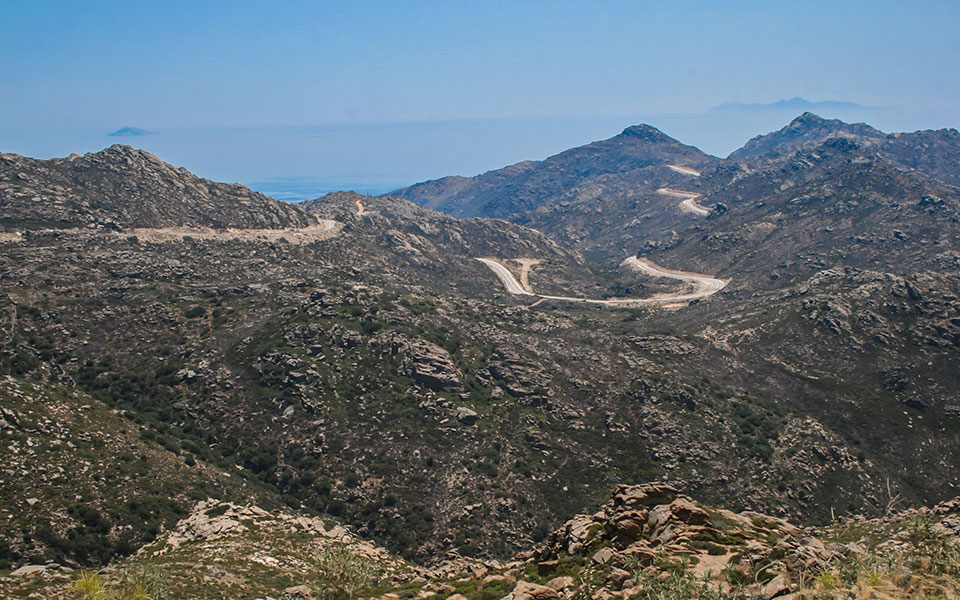
Beyond the main village of Hora and its port, the rest of Ios is largely empty.
© Shutterstock
Driving in Ios, if you like to drive, is a heavenly enterprise. Fifteen minutes out of the bar hopper’s heaven that is Hora I half expect to see a road sign screaming “We have the world’s best roads!” Or something to that effect because the exhilarating switchbacks and sweeping views and scarcity of other drivers (this is in mid-September) make for a holy trinity of sorts: I can think of nowhere else in the world, for example, where a road can make you feel as if you are literally – yes – flying over the island of Santorini. Oia, Santorini’s cinematic star village, is just a few miles due south of the southernmost point on Ios, and on a clear day these soft purple views across the Aegean to the high backside of the volcanic celebrity are not simply spectacular, they are transfiguring.
And to think that all I really want is to find a nice beach!
In Ios there are plenty of them. I will eventually find my bliss in Manganari, actually a series of three beaches with flawless golden sand and fantastically glass-clear aquamarine water, but it’s the getting there that leaves me confounded.
Generally speaking, the more goats blocking your way the more authentic the island, and in that regard too Ios doesn’t disappoint: en route I’m intermittently stymied by goats, donkeys and bulls too but it’s the look of this island’s interior that provokes wonderment.
It’s not that the land itself is terribly beautiful but there is a dramatic rocky aspect to it, as if two ancient titans were playing volleyball with a giant boulder that didn’t quite clear the celestial net, crashing instead into a billion pieces that rolled all the way down to the aquamarine shore at Manganari and other Ios coasts. At some points I have the feeling I am rolling through the Arizona desert, but then just as suddenly and improbably, the road climbs to such heights that vistas of distant islands (is that Amorgos over there?) come into view and beaches below materialize like secret coves that you’re floating over by helicopter.
Right before the road descends to Manganari there is (surprise!) a little white church on the left and I stop the car. Far below the curving beach of Tris Klisies beckons, and the only way to get there is by foot or by boat, so I take a 15-minute hike through the aromatic brush to this secret bastion of blue. I find two naked German tourists. On the way back, I get lost, very lost, and (should’ve said my prayers at that little church) almost collapse from dehydration.
There are more beaches in Ios than I will have time for, and I sadly miss Kalamos, but not the graceful Byzantine monastery above it. Far below it is a hotel development that is perhaps prematurely touted, as it encroaches on what had been a pristine chunk of Ios’s coast. Hopefully it won’t become another Koumpara, the beach close to the port that’s also home to Erego Beach Club, a place so flamboyant and monumental in scale it makes Lindsay Lohan’s place in Mykonos look like child’s play. But it’s the same owner, islanders whisper, so get your nature fix on here while you can.
What Ios lacks in metropolitan offerings, it more than makes up for in beach bliss. By far the most famous, though it’s not everyone’s favorite, is Milopotas. This wide arc of sand just three kilometers south of Hora has done more than perhaps anything to give Ios its somewhat unjust reputation as a party island, but not too surprising when you consider that party boys do make the most noise. It does help to be in your 20s to tap in to the Milopotas vibe, but if you want to experience something different and also close to Hora, try Koumbara Bay which is three kilometers northwest of the port (an easy half-hour walk). The beach there is excellent and it’s also home to the over-the-top Erego Beach Club, a venue only matched for flamboyance by the Pathos lounge bar behind it, under the same management and noted for its theatrical sundowners.
Manganari Beach is a stunner 23 kilometers south of Hora and actually three beaches: one large one plus two smaller coves. On the north coast there’s a good beach at Psathi, and more secluded ones on the eastern side of the island at Plakes, Kalamos, and Tris Eklises (the last is clothing-optional and requires a long walk).
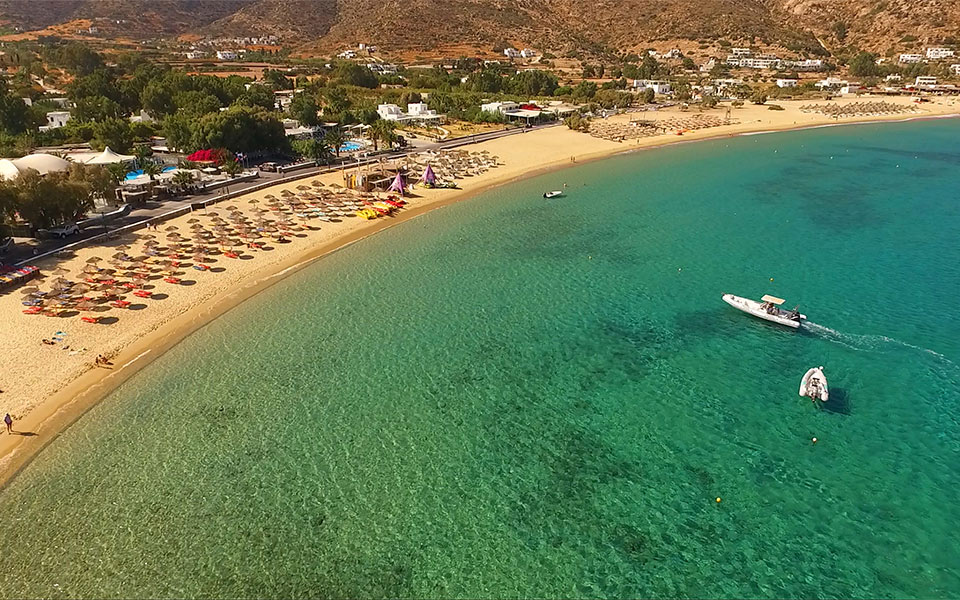
The huge Mylopotas Beach draws many of the island's visitors and features several beach bars.
© Shutterstock
Suffice it to say that Manganari is the apotheosis of Aegean beach nirvana. Where am I, really? Ibiza? Ios is kind of shaped like Ibiza. The hippie heritage and its reputation as a party spot centering on the wide/wild beach at Milopotas fit that bill. Or a fragment of Australia? Illusory as it is, Ios can feel as remote as a lost continent, and though it’s small, the scale of things can surprise you. It’s a question that I will be asking myself repeatedly over the course of the three days I’m rambling around the island.
As I wander, other non-sights intrigue: a crumbling hilltop fortress here, a Neolithic settlement there, another stunner of a secret beach. Every so often, and usually up the hill from a church, I spot what appears to be a smattering of tiny blue coffins but I come to realize (thanks to Vangelis’s Ios-splaining) they are put there to collect honey. I imagine that come springtime the wildflowers must be an incredible sight to behold; various islanders including Vangelis confirm this.
And who knew, really? Like, did you know that Ios has a lock on Greek literary heritage bar none? It’s the home of Homer’s Tomb, set with quiet fanfare on a rocky promontory on the northern tip of the island. Whether the poet’s links to Ios are authentic or mostly apocryphal, the tomb is definitely there – just follow the well-marked path – and it is as fabulously lonely a spot as you’ll find in this part of the Aegean.
Ios is not known as a gourmand’s isle however that doesn’t mean you can’t find a good meal. It’s hard to go wrong by any of the tavernas facing the port but for the best homestyle Greek cooking, the must stop is Vilaeti Taverna at Pano Kampos, in the hills north of Hora. There’s a string of decent restaurants and tavernas facing Gialos Bay (by the port) and by Koumbara Beach, Polydoros Taverna is also a solid bet.
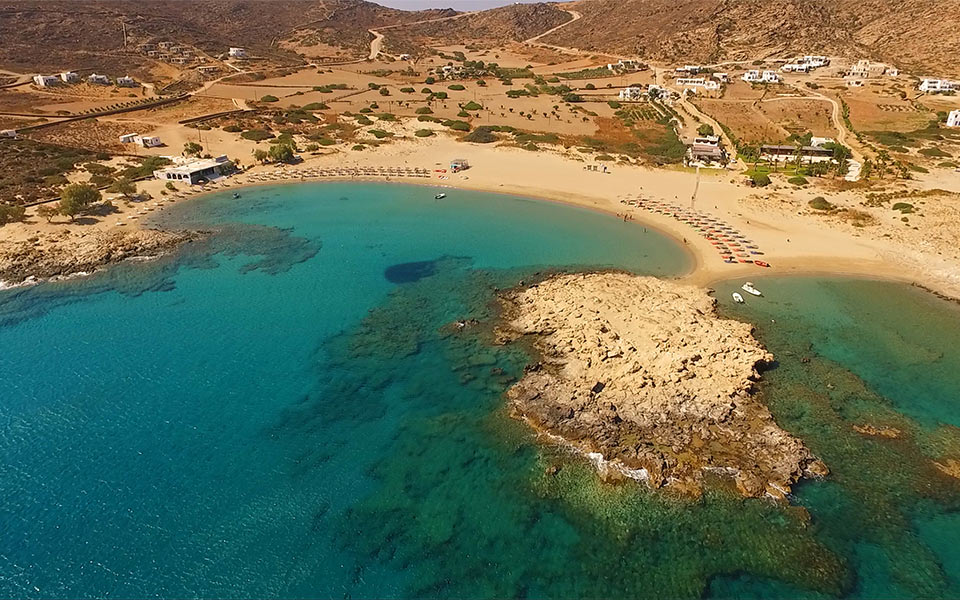
Manganari Beach
© Shutterstock
But for me Ios is going to be all about churches and beaches and the self-directed rollercoaster ride that is driving between them all. The absence of touristic iconography is an all-season kind of force, bringing unanticipated details into sometimes befuddling relief.
Case in point: On the way to Homer’s tomb I catch sight of what appears to be a larger-than-life sculpture of a male nude, or half of one anyway, bending over by the roadside, the posterior unapologetically brandished to anyone who happens to coast by. No one and nothing else is around. I hit the brakes and get out of the car to inspect the artwork, looking for a plaque of some kind. But there is no clue at all. I ask around later, but people just shrug.
Back in the vehicle, ignition and radio on, through the static I hear what sounds like an ethereal Greek Orthodox chant intercut with synthesizers and rap. Does one of those monasteries on high house a secret club with a progressive neo-Byzantine DJ spinning in the cellar, or is just Radio Mykonos? Who knows? Mystery follows little mystery, wrapped in rock and some seriously heart-stopping ribbons of blue, and slowly I come to understand what this island of 365 churches really is: a gift.
Just an hour from Athens, Kea...
Discover hidden beaches, authentic tavernas, ancient...
A magical open-air cinema in Kimolos...
From ancient healing sanctuaries to legendary...